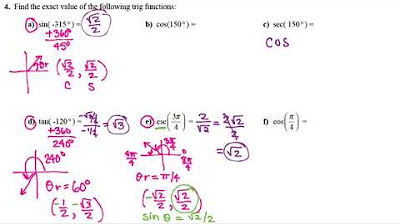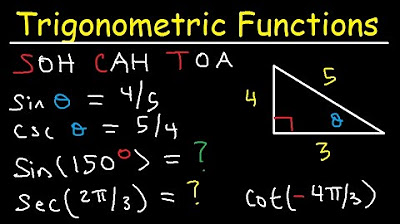Calculus AB Homework Day 2 - Review 2: Functions and Trig
TLDRThis educational video script offers a detailed walkthrough of a homework assignment focusing on function composition and trigonometry. It explains the process of evaluating composite functions for given values, using both algebraic and graphical methods. The script also covers the determination of trigonometric functions for specific angles, including quadrant analysis and the use of reference angles. Additionally, it addresses solving trigonometric equations and identifying the values of six trigonometric functions for given angles, providing a comprehensive review suitable for students.
Takeaways
- 📚 The video is a tutorial on a day two homework assignment focusing on the review of functions and trigonometry.
- 🔍 The first task involves evaluating composite functions like f(G(x)), G(f(x)), f(f(x)), and G(G(x)) for given values of x.
- 📉 The method demonstrated for solving composite functions is to work from the inside out, using tables for function values.
- 📝 For composite functions involving trigonometry, the video explains how to find exact values using the unit circle and reference angles.
- 📈 The video also covers evaluating composite functions using graphs, where one must find the input on the inner function's graph and then use the output as the input for the outer function.
- 🔢 Examples of finding composite functions for specific values like f(G(-2)), f(G(-3)), and others are given, showing step-by-step calculations.
- 📐 The video explains how to determine the values of functions f(x) and g(x) such that the composite H(x) = f(g(x)) holds true for given equations.
- 🤔 The script touches on solving trigonometric equations, such as finding angles given certain trigonometric function values, using the properties of right triangles and the Pythagorean theorem.
- 📉 The process of solving for angles in trigonometric equations involves understanding the signs of trigonometric functions in different quadrants and using special triangle ratios.
- 🔄 The video mentions the periodic nature of trigonometric functions, explaining how to find all solutions by adding or subtracting multiples of the function's period.
- 📝 Lastly, the script includes solving quadratic trigonometric equations by treating them as standard quadratic equations and finding the solutions for the trigonometric functions.
Q & A
What is the first problem in the video script about?
-The first problem is about evaluating composite functions f(G(x)), G(f(x)), and G(g(x)) for given values of x, starting with x = 1.
How does the script approach the evaluation of f(G(1)) in the first problem?
-The script evaluates f(G(1)) by working from the inside out, first finding G(1) which is 3, and then finding f(3) which is 5.
What is the result of G(f(1)) in the video script?
-G(f(1)) is calculated as G(4) because f(1) equals 4, and G(4) is found to be 2.
How is the value of f(f(1)) determined in the script?
-The script determines f(f(1)) by first finding f(1) which is 4, and then evaluating f(4) which gives the result of 2.
What is the process for evaluating trigonometric functions in the script?
-The script evaluates trigonometric functions by identifying the quadrant the angle lies in and using reference angles along with the signs of the trigonometric functions in those quadrants.
What is the sine of 2π/3 according to the video script?
-The sine of 2π/3 is √3/2, as it is in Quadrant 2 where sine is positive.
How does the script handle the evaluation of secant of π?
-The script evaluates secant of π by recognizing that the cosine of π is -1, and since secant is the reciprocal of cosine, the result is -1.
What is the approach to finding the values of trigonometric functions when θ equals arcsine(-4/9)?
-The script uses the definition of arcsine to determine that sine θ equals -4/9, then applies the Pythagorean theorem to find the remaining side of the right triangle, and uses the signs of the trigonometric functions in Quadrant 4 to find the other trigonometric values.
How does the script solve for x in the equation 2sinx + √2 = 0?
-The script isolates sinx by adding and subtracting √2, then dividing by 2, resulting in sinx = -√2/2. It then identifies the angle x where sine equals -√2/2 as 5π/4 and 7π/4, and generalizes the solution to x = 5π/4 + 2πk and x = 7π/4 + 2πk for integer values of k.
What is the solution for the equation 3tan²θ - 1 = 0 in the script?
-The script solves the equation by factoring it into (√3tanθ + 1)(√3tanθ - 1) = 0, resulting in solutions of tanθ = √3/3 and tanθ = -√3/3, which correspond to angles π/6 and 5π/6 plus multiples of π.
How does the script approach the quadratic equation in the form of 2sin²x - sinx - 1 = 0?
-The script substitutes sinx with W, resulting in a quadratic equation 2W² - W - 1 = 0, which is factored into (2W + 1)(W - 1) = 0, yielding solutions W = -1/2 and W = 1. It then translates these back to sinx, finding angles where sine is -1/2 and 1.
Outlines
📚 Composite Function Evaluation
The video script begins with an explanation of evaluating composite functions for a day two homework assignment. The instructor demonstrates how to find the values of composite functions f(G(x)), G(f(x)), f(f(x)), and G(G(x)) for given x values by working from the inside out. The process involves looking up the function tables for f and G, and calculating the results step by step. The instructor also addresses cases where the function values cannot be determined due to missing information in the tables.
📈 Evaluating Composite Functions Using Graphs
This section of the script focuses on evaluating composite functions using their graphs. The instructor explains how to determine the output values for expressions like f(G(-2)), f(G(-3)), and others by looking at the corresponding points on the graphs of the functions f and g. The process involves identifying the input values on the graphs, finding the corresponding output values, and then using those as inputs for the next function in the composite expression.
🔍 Advanced Composite Function Problems
The script continues with more complex problems involving composite functions. The instructor guides through the process of identifying inside and outside functions and composing them to form a new function H(x). Examples include finding functions f(x) and g(x) such that H(x) = f(g(x)) and solving for x in various scenarios. The approach involves understanding the composition of functions and applying the correct rules to find the solutions.
📉 Trigonometric Function Evaluations
This part of the script deals with evaluating trigonometric functions at specific angles. The instructor explains how to find the sine, cosine, secant, tangent, and other trigonometric functions for angles in different quadrants. The process includes identifying the reference angles, understanding the signs of the trigonometric functions in each quadrant, and using the reciprocal relationships between them to find the required values.
🧭 Solving Trigonometric Equations
The script presents methods for solving trigonometric equations involving arcsine and arccosine. The instructor demonstrates how to use the properties of right triangles and the Pythagorean theorem to find the values of the six trigonometric functions for a given angle. The process involves recognizing special angles, understanding the relationship between the sides of a right triangle, and applying trigonometric identities to solve for unknowns.
🔢 Solving for Angles in Trigonometric Equations
The final section of the script involves solving for angles in trigonometric equations. The instructor explains how to isolate the angle variable and find the solutions by adding or subtracting multiples of the period of the trigonometric functions involved. The process includes recognizing the periodic nature of trigonometric functions and using this property to find all possible solutions within a given range.
Mindmap
Keywords
💡Composite Functions
💡Trigonometry
💡Evaluation
💡Graphs
💡Special Trigonometric Values
💡Unit Circle
💡Quadrants
💡Inverse Trigonometric Functions
💡Pythagorean Theorem
💡Reciprocal Trigonometric Functions
Highlights
Introduction to the video covering day two homework assignment on functions and trigonometry.
Explanation of evaluating composite functions f(G), G(f), f(f), and G(G) for given x values.
Step-by-step process for finding f(G) of 1 using function tables.
Demonstration of working from the inside out to evaluate composite functions.
Finding G(f) of 1 and illustrating the process with function tables.
Solving for f(f) of 1 and G(G) of 1 using the given function values.
Continuation of the method to evaluate composite functions for different x values.
Inability to determine f(G) of 3 due to missing function table values.
Evaluating composite functions using graphs instead of tables.
Graphical method to find f(G) of negative 2 and its output value.
Composite function evaluation using trigonometric functions and their properties.
Explanation of how to determine an f(x) and g(x) such that H(x) equals f(g(x)) with an example.
Approach to finding trigonometric values for special angles using reference angles.
Use of Pythagorean theorem to find missing sides in right triangles for trigonometric functions.
Solving trigonometric equations by transforming them into quadratic forms.
Identification of special trigonometric values for specific angles on the unit circle.
Solving for all possible solutions of trigonometric equations over different cycles.
Final solutions for the given trigonometric problems, including angles in different quadrants.
Transcripts
5.0 / 5 (0 votes)
Thanks for rating:





